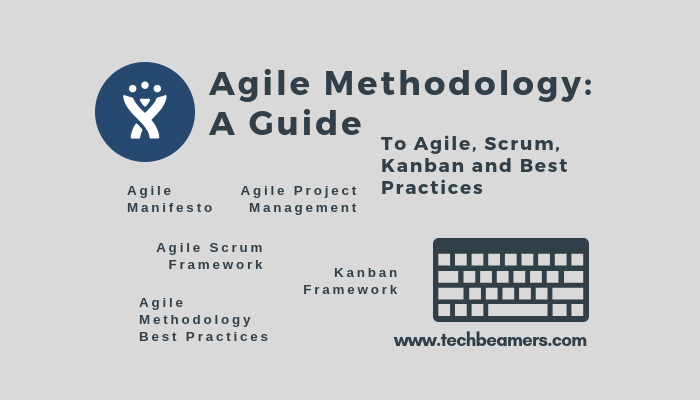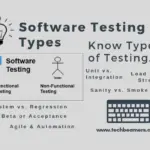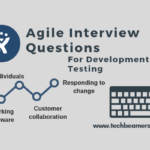This tutorial aims to teach you about Agile methodology or Agile process in simple and easy steps. The underlying philosophy of Agile is to bring people to work together and accomplish a common goal. Here, our focus is on how the team can work together, plan, execute, and deliver quality Software following the Agile mindset.
Agile is also a type of modern SDLC. From this tutorial, you’ll get to the basic concept of Agile methodology, its principles and manifesto, various techniques, and how to use them at work. The scope of Agile is not only limited to software developers, but it applies to Tech Leaders, Engineering Managers, Product Managers, Testers, Tech Pubs, and anyone associated with a release. The agile process is flexible, and fast, and promotes continuous delivery and improvements in quality.
Agile Methodology
The Need for Agile Methodology
Before you adapt to the Agile process, you first need to acknowledge that the legacy “Waterfall” way of Software development has a lot of gaps to fill. The sequence of “Plan, Design, Execute, Validate, Deliver” might work for producing mobile phones or infrastructure projects but not the same for building Software applications. In a dynamic business environment where the cost and competition drive the changes, it’s the Agile methodology that has been successful in drawing a delicate balance between the expectations and the execution.
What is the Agile Methodology?
Agile Methodology is a modern software development method for executing a project from inception to its end. It introduces the concept of failing faster which only means getting quick feedback on the work done. By executing in this manner, it expects to reduce the risk of failure after spending months on a project or a late discovery of a mismatch in requirements. Agile defines a value system where the teams and the individuals get more ownership in planning, design, development, and execution. It inculcates trust, confidence, and goodwill among them.
The success of the Agile process depends on the team and each member works directly with the customer to understand the real picture and propose solutions quickly and incrementally. The following are the influential factors of the Agile methodology.
Short and quick
Legacy software development processes like Waterfall used to have phases like requirements collection, planning, design, coding, testing, and release.
On the contrary, Agile methodology aims to deliver the entire release in the form of increments in a couple of weeks and the fully functional version in a few months.
Communication
In Agile, the teams meet daily, exchange info, and discuss impediments at every stage of the project. Such collaboration and exchange of ideas guarantee the release stays on track even if the scope changes a bit.
Feedback
This is the beauty of the agile process. Since the team delivers features in increments, they get quick feedback from Dev, QA, PO, and customers. That’s how the Agile methodology helps in tracking the progress of the development cycle regularly.
Trust
In Agile, the teams and each member are self-organizing. The process backed by the management empowers them to understand the goals and define their respective paths to reach success.
Adjustment
The agile team can quickly align and adjust the process based on the need. The KIS or Keep It Simple principle is what guides them.
Timeline of Agile Software Development
The software industry saw a bit of a crisis in the early 1990s. Some called it “the application development crisis” and some referred to it as “application delivery lag.” The problem was the inability to meet customer demands and requirements. Also, the processes at that time used to take a long time to deliver the product. They were using a timeline-based approach, where the development process was sequential, and the customers had to wait until the very final step. The more the delivery time, the more the chances for customers to change their specifications. So, by the time the application was ready, the original requirements would have lost relevancy.
Even, there were projects that got to stop in the midway. Hence, the professional leaders of the software industry had to think of a new approach to address the above issues. In 2001, some of these leaders met in Utah and conceptualized the idea of Agile. They were all in sync to materialize this process and recognized it at the industry level. They also devised agile guidelines and named the document the Agile Manifesto.
What is the Agile Manifesto?
The Agile Manifesto is an advisory that contains the values and principles to follow in the Agile methodology.
It includes four foundational values and twelve principles. Each has a purpose to help explore better ways of developing software.
The Agile Manifesto proposes to have a clear and measurable structure and encourages iterative development, team collaboration, and acceptance of changes.
You can read about the values and principles of the Agile Manifesto from below:
Agile Values
1- Trust individuals and prefer interactions over processes and tools
2- Focus on delivering working software rather than complete documentation
3- More customer involvement than just negotiation
4- Willing to accommodate changes instead of being rigid to a plan
Agile Principles
1- Short development cycles, quick delivery, and happy customer
2- Accept scope changes, revise goals
3- Continuous delivery of working software
4- Collaboration between all stakeholders throughout the project
5- Show confidence in the people involved
6- Allow transparent interactions
7- Working software defines the progress
8- Agile processes to normalize the development speed
9- Refer to design and technical details
10- Simplicity
11- Self-organizing is the key to good architectures, requirements, and designs
12- Revisit how to become more efficient
The people following the Agile methodology should align with these values and principles. The Agile Manifesto provides clarity on the Agile development lifecycle practices.
Agile Project Management
Agile project management is a proven method to produce complex projects on time. It stresses the following aspects.
- Collaboration,
- Flexibility,
- Continuous improvement, and
- High-quality deliverables.
It makes use of six primary “deliverables” to monitor the progress and release of the product.
Following are the deliverables.
Product vision statement
A summary that defines the goals of the product.
Product roadmap
A high-level overview of the requirements to implement.
Product Backlog
The complete list of features to be added to the project.
Release plan
A graphical document to show the release progress.
Sprint backlog
The list of user stories picked in the latest sprint.
Increment
The working product with features implemented in the current sprint cycle.
There are many frameworks for Agile project management that you can pick and start developing a product. Each of them has a unique feature set and terminology. But they all follow the same principles and practices.
The most famous ones are Scrum and Kanban which support the Agile development lifecycle.
Agile Scrum Framework
Scrum is the most used Agile framework. It helps in applying the practices laid down by Agile software development. Jeff Sutherland and Ken Schwaber were the two of thirteen members who devised the Agile Manifesto. It includes the following five values:
1- Commitment,
2- Courage,
3- Focus,
4- Openness, and
5- Respect.
It helps to create, deliver, and maintain difficult products through collaboration, answerability, and interactiveness.
What puts Scrum aside from other Agile frameworks are the roles, events, and a set of artifacts that it uses to achieve the release goals. They are as follows:
Roles in the Scrum Framework
Product owner
A person who is an interface for the stakeholders, and a messenger of the customer.
Development team
A team of self-organizing members who work to deliver the product (developers, QA, UI/UX)
Scrum master
A person who addresses the blockers. He brings the team together, enforces Scrum execution, and imparts process awareness.
Scrum events
Sprint
A cyclic development process has a fixed timeframe for each cycle in a release. Its purpose is to accomplish the sprint goals.
Sprint planning
A planning meeting which occurs at the onset of every sprint to define the goals for the current cycle.
Daily Scrum
It’s a time-bound meeting of fifteen minutes duration and occurs every day at the same time for a release. It provides a platform to discuss the previous day’s achievements and the expectations for the next day.
Sprint review
A meeting occurs when the Sprint ends. Here, the Scrum team demonstrates the features done in that cycle.
Sprint Retrospective
It is a meeting for the team to re-look at the way the previous sprint has gone and decide on the action items for the next cycle.
Scrum Artifacts
Product Backlog
A comprehensive work catalog created by the product owner to keep the customer requirements in the form of user stories.
Sprint backlog
A smaller work catalog derived from the product backlog includes items for implementation in the current sprint.
Kanban Framework
Kanban is a visualization-centric method that is also quite famous for Agile project management. It sketches a real-time picture of the project workflow to ensure early discovery of bottlenecks in the process and on-time delivery of the higher quality product.
It lays down the six general practices which are as follows:
1- Visualization-centric
2- Restricting work in progress
3- Workflow management
4- Keep policies explicit
5- Encourage feedback loops
6- Collaborative or innovative evolution
It was in the 1940s when the production line of Toyota factories thought of this concept. Its purpose was to bring in efficiency with the help of visual aids for showing milestones of the development process.
A Kanban framework has the following key elements.
Kanban board
A visual dashboard that showcases the development workflow. It can be both physical (a whiteboard or sticky notes) or virtual (a tool like Jira). You can use it for personal productivity, as well as teamwork.
Kanban cards
The card represents a work unit/item in the entire work process. You can use it to share the progress within the team. It can take many forms such as a status, a timeframe, or the project deadlines.
Kanban swimlanes
It is another visual element on the dashboard that helps in segregating work units/items by grouping them. It spans horizontally, enables filtering, and gives a clear picture of the workflow.
Agile Methodology Best Practices
We are outlining seven best practices of Agile Methodology that you should use while implementing any of the available Agile frameworks.
Customer Collaboration
The Agile Manifesto includes it as one of its core values. It’s an integral part of the Agile methodology. With continuous communication, the dev team, PO, and the customer would always have a clear view of the progress. Their united effort will lead to delivering a quality product.
User Stories
The PO should create user stories as they describe a software feature from a customer perspective. A User Story is nothing but a simple form of the requirement. It helps to understand the user’s context of the product, what he wants, and the reason(s) for having it.
Continuous Integration
Continuous Integration (CI) is an industry-wide practice for regulating the development process. It organizes the development process and stabilizes the product by creating daily or frequent builds. The goal of CI is to optimize the time and effort spent on the integration.
Automated Testing
Automation is the lifeline for any Agile framework. It helps to establish that the regular changes are not breaking anything in the code. It also ensures that the code changes are acceptable or not. Building a regression test suite is what should be the objective of Agile teams.
The team should continually add the regression tests to avoid any manual verification of the features delivered in previous increments.
Pair Programming
It is an agile technique in which two programmers carry out development in a pair. One writes the code whereas the other does the review. They can also switch roles frequently.
Test-driven Development (TDD)
TDD encourages simple designs and thus brings in confidence. The agile team prepares test cases for the requirements, automates them, and then uses them to qualify as a stable software build.
Burndown Charts
A burndown chart is a graph-based reflection of the work that is pending versus the time to finish it. In Agile project management, such a technique makes us forecast the completion timeframe. It can also portray the number of User Stories per unit of time.
Summary – Agile Methodology
Indeed, Agile Methodology is a powerful tool for software teams looking for a resilient strategy for product development. It has proved that Agile also applies to the software industry.
Any IT business that needs a quick action plan can utilize Agile for better customer collaboration, efficient teamwork, conscious changes, and nonetheless, quality results.
We hope the Agile methodology could improve the way your team currently works. If you wish to see more such updates, then please follow us on our social accounts.









